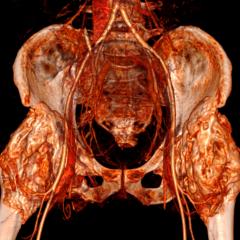Queensland’s newest world-class research facility celebrated a major milestone at the weekend with the craning-in of three clinical scanners, two of which had been cooled in liquid helium for their journey from Germany.
The $22 million Herston Imaging Research Facility (HIRF), due to open in August this year, is one of only a handful of imaging research facilities in Australia and the first to be devoted entirely to clinical research.
HIRF is an alliance between four of Queensland’s most influential research and clinical institutions: The University of Queensland (UQ), the QIMR Berghofer Medical Research Institute; Queensland University of Technology; and the Metro North Hospital and Health Service through the Royal Brisbane and Women’s Hospital (RBWH).
Leading healthcare company Siemens is HIRF’s industry partner, supplying the three clinical scanners that are so powerful that they will revolutionise the treatment of serious diseases, including cancer, dementia and mental illness.
HIRF’s acting director Professor Stephen Rose said the facility had been built to cater for the growing role of imaging in clinical research and would give researchers unprecedented access to high-quality imaging equipment.
“As a purpose-built clinical imaging research facility, HIRF will enable research to progress at a fast pace and ensure research findings are rapidly translated into the clinical healthcare environment,” Professor Rose said.
“The scanners are different from those being used now for diagnostic imaging of patients as they combine anatomical, molecular and functional processes to help researchers improve understanding of disease and to quickly determine whether treatments are effective.
“For example, in cancer research, the scanners will not only pinpoint a tumour’s location and size, but whether that tumour tissue is active.
“In the case of neurological diseases such as dementia or mental illnesses such as schizophrenia, the scanners will enable detailed studies of how the brain is wired.
“No matter what the condition, the scanners will provide important information for researchers who are ultimately trying to prevent and treat disease, and ensure health funding goes to the most effective treatments.”
Siemens Healthcare’s Vice President for Clinical Products Peter Spryszynski said his company was always innovating to advance human health.
“We are proud to be the trusted partner of HIRF for providing cutting-edge technology that will help fight the most threatening diseases,” he said.
HIRF is at the Brisbane Metro North Hospital and Health Service Herston precinct, which means patients, doctors and researchers will be involved in research.
Professor Rose said the facility broke new ground as imaging specialists would have to be cross-trained on scanners that offered hybrid imaging techniques such as magnetic resonance imaging (MRI) and positron emission tomography (PET) scanning in a single machine.
The imaging equipment was funded by a $3 million Queensland Government grant; $3 million from the Commonwealth Government; a $2 million grant from the Australian Cancer Research Foundation; $1.5 million from the RBWH Private Practice Trust Fund; and partner contributions.
Media: Kate Gadenne, 0438 727 895, k.gadenne@uq.edu.au or Bernadette Condren, 0413 881 597, b.condren@uq.edu.au



